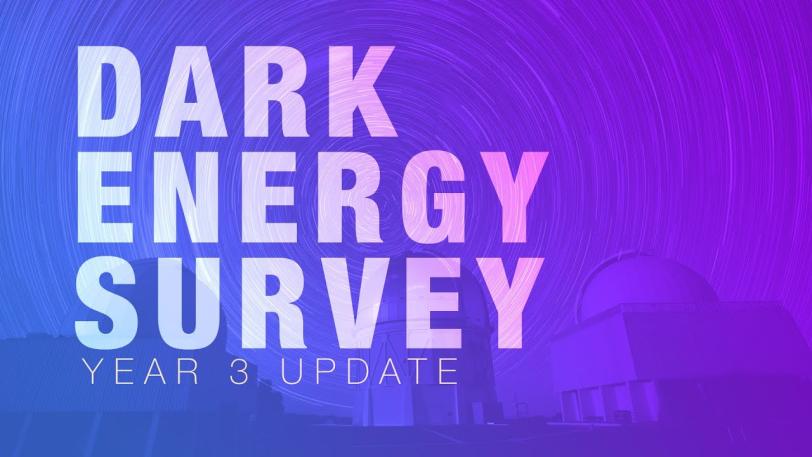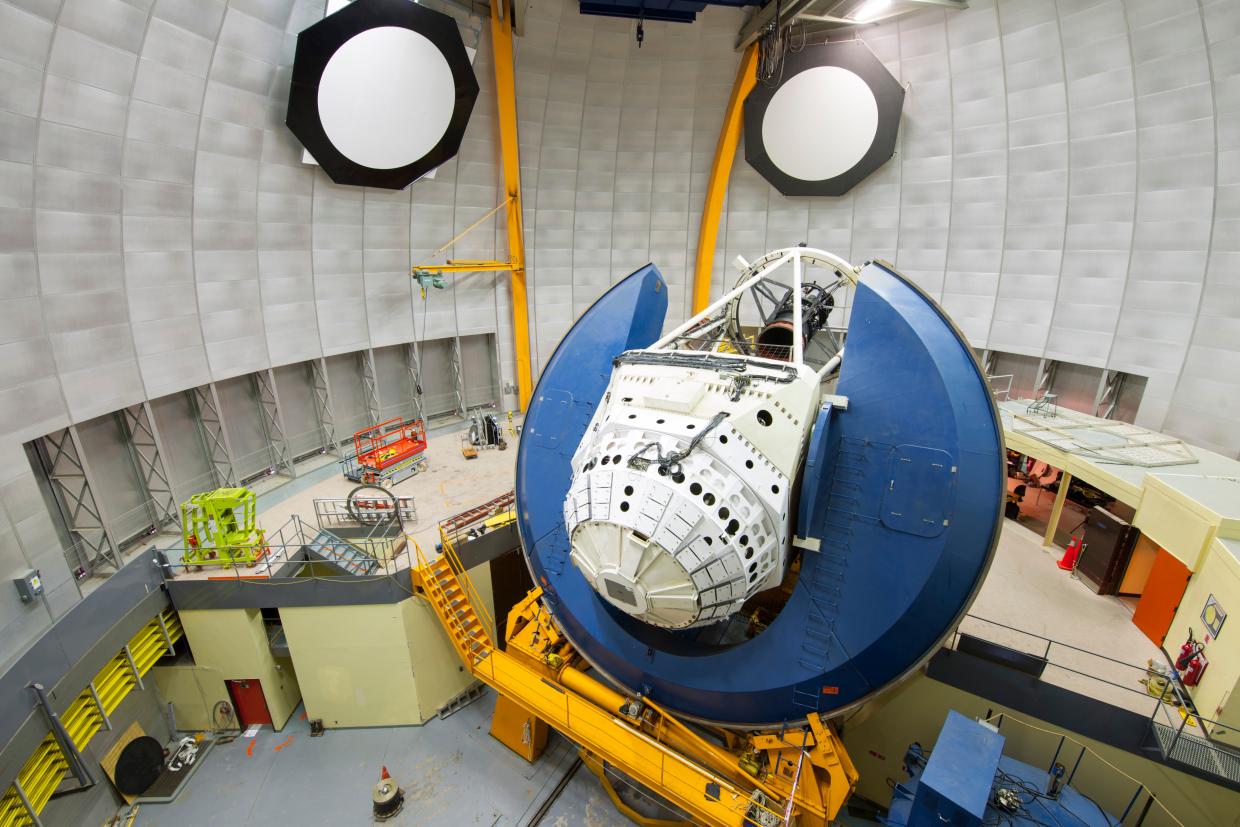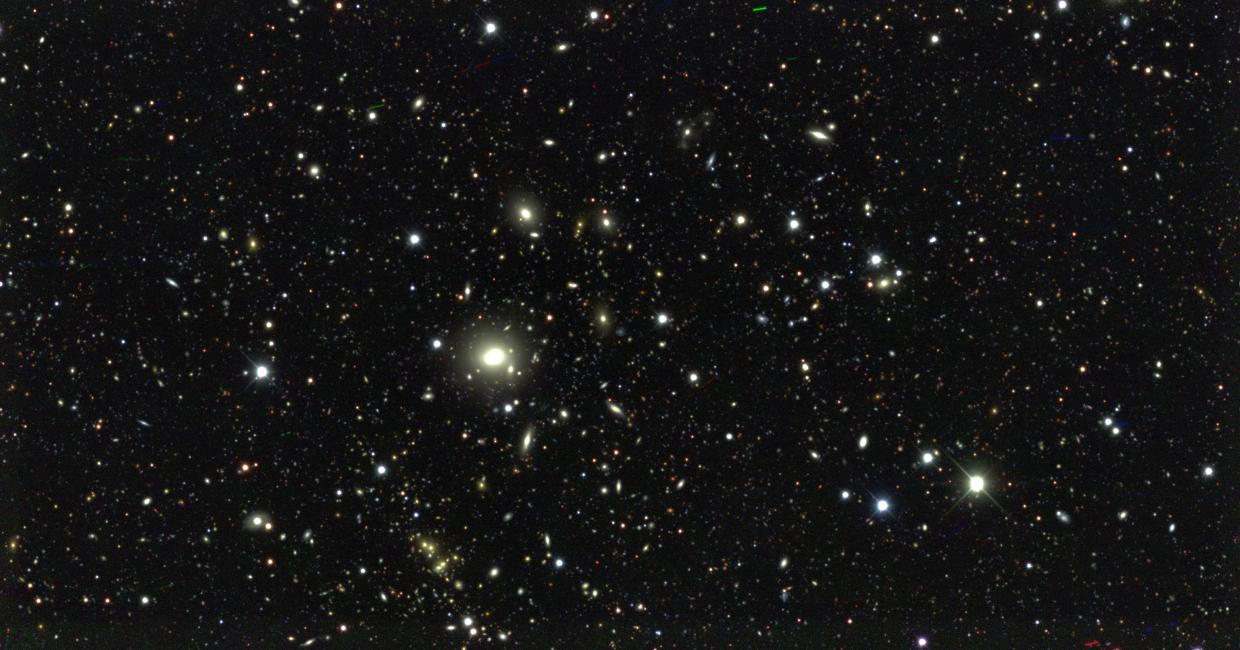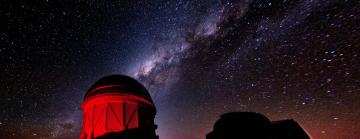Dark Energy Survey releases most precise look at the universe’s evolution
An analysis of the first three years of Dark Energy Survey data is consistent with predictions from the current best model of the universe. Nevertheless, hints remain from DES and other experiments that matter in the current universe is a few percent less clumpy than predicted.
New results from the Dark Energy Survey use the largest ever sample of galaxies over an enormous piece of the sky to produce the most precise measurements of the universe’s composition and growth to date. Those measurements reveal that the way matter is distributed throughout the universe is consistent with predictions in the standard cosmological model, the best current model of the universe.

Exploring 7 billion light years of space with the Dark Energy Survey
Over the course of six years, DES surveyed 5,000 square degrees – almost one-eighth of the entire sky – in 758 nights of observation, cataloguing hundreds of millions of objects. The results announced today draw on data from the first three years – 226 million galaxies observed over 345 nights – to create the largest and most precise maps yet of the distribution of galaxies in the universe at relatively recent epochs.
Since DES studied nearby galaxies as well as those billions of light-years away, its maps provide both a snapshot of the current large-scale structure of the universe and a movie of how that structure has evolved over the course of the past 7 billion years.
New limits and intriguing hints
To test cosmologists’ current model of the universe, DES scientists compared their results with measurements from the European Space Agency’s orbiting Planck observatory. Planck used light signals known as the cosmic microwave background to peer back to the early universe, just 400,000 years after the Big Bang. The Planck data give a precise view of the universe 13 billion years ago, and the standard cosmological model predicts how the dark matter should evolve to the present. If DES’s observations don’t match this prediction, there is possibly an undiscovered aspect to the universe. While there have been persistent hints from DES and several previous galaxy surveys that the current universe is a few percent less clumpy than predicted – an intriguing find worthy of further investigation – the recently released results are consistent with the prediction.
“In the area of constraining what we know about the distribution and structure of matter on large scales as driven by dark matter and dark energy, DES has obtained limits that rival and complement those from the cosmic microwave background,” said Brian Yanny, a scientist at the Department of Energy’s Fermi National Accelerator Laboratory who coordinated DES data processing and management. “It’s exciting to have precise measurements of what’s out there and a better understanding of how the universe has changed from its infancy through to today.”
“This is the most sensitive experiment observing relatively nearby objects so far, and still our finding is pretty consistent with our current model of the universe,” said Risa Wechsler, director of the Kavli Institute for Particle Astrophysics and Cosmology at DOE’s SLAC National Accelerator Laboratory and Stanford University. But, she said, the fact that the latest results suggest the universe may be slightly less clumpy than earlier thought merits further investigation. SLAC researchers, who have developed simulations of the universe, calibrations of the distances to the galaxies, and other tools central to the analysis, will continue to make key contributions as DES moves forward with the next round of data.
Ordinary matter makes up only about 5% of the universe. Dark energy, which cosmologists hypothesize drives the accelerating expansion of the universe by counteracting the force of gravity, accounts for about 70%. The last 25% is dark matter, whose gravitational influence binds galaxies together. Both dark matter and dark energy remain invisible and mysterious, but DES seeks to illuminate their natures by studying how the competition between them shapes the large-scale structure of the universe over cosmic time.
DES photographed the night sky using the 570-megapixel Dark Energy Camera on the Victor M. Blanco 4-meter Telescope at the Cerro Tololo Inter-American Observatory in Chile, a Program of the National Science Foundation’s NOIRLab. One of the most powerful digital cameras in the world, the Dark Energy Camera was designed specifically for DES. It was funded by the DOE and was built and tested at DOE’s Fermilab. The DES data were processed at the National Center for Supercomputing Applications at the University of Illinois at Urbana-Champaign.
“These analyses are truly state-of-the-art, requiring artificial intelligence and high-performance computing super-charged by the smartest young scientists around,” said Scott Dodelson, a physicist at Carnegie Mellon University who co-leads the DES Science Committee with Elisabeth Krause of the University of Arizona. “What an honor to be part of this team.”

Analyzing the dark
To quantify the distribution of dark matter and the effect of dark energy, DES relied on two main phenomena. First, on large scales, galaxies are not distributed randomly throughout space but rather form a weblike structure due to the gravity of dark matter. DES measured how this cosmic web has evolved over the history of the universe. The galaxy clustering that forms the cosmic web, in turn, revealed regions with a higher density of dark matter.
Second, DES detected the signature of dark matter through weak gravitational lensing. As light from a distant galaxy travels through space, the gravity of both ordinary and dark matter can bend it, resulting in a distorted image of the galaxy as seen from Earth. By studying how the apparent shapes of distant galaxies are aligned with each other and with the positions of nearby galaxies along the line of sight, DES scientists inferred the spatial distribution (or clumpiness) of the dark matter in the universe.
Analyzing the massive amounts of data collected by DES was a formidable undertaking. The team began by analyzing just the first year of data, which was released in 2017. That process prepared the researchers to use more sophisticated techniques for analyzing the larger data set, which includes the largest sample of galaxies ever used to study weak gravitational lensing.
Alexandra Amon, a Kavli Fellow at SLAC and Stanford, who co-led the weak-lensing analysis, said “Our results are particularly exciting because of the methodological advancements that we developed in order to harness the cosmological information from the images. It’s an enormous feat for our team to accurately analyze a dataset with a dataset with such unprecedented power! That's where SLAC researchers played a key role – in ensuring that the results were robust in terms of data calibration, by developing state-of-the-art techniques, as well as model validation, through building cosmological simulations to test the model.”
For example, calculating the redshift of a galaxy – the change in light’s wavelength due to the expansion of the universe – is a key step toward measuring how both galaxy clustering and weak gravitational lensing change over cosmic history. The redshift of a galaxy is related to its distance, which allows the clustering to be characterized in both space and time.
SLAC researchers, including graduate student Justin Myles, led significant advances in how to calibrate the redshift distributions. Judit Prat, a postdoc at the University of Chicago who analyzed weak gravitational lensing as captured by DES said “This was a huge effort that people put a lot of work into. We now have a method that nobody has used before, and it’s very robust.”

The deep field
Ten regions of the sky were chosen as “deep fields” that the Dark Energy Camera imaged repeatedly throughout the survey. Stacking those images together allowed the scientists to glimpse more distant galaxies. The team then used the redshift information from the deep fields to calibrate measurements of redshift in the rest of the survey region. This and other advancements in measurements and modeling, coupled with a threefold increase in data compared to the first year, enabled the team to pin down the density and clumpiness of the universe with unprecedented precision.
Along with the analysis of the weak-lensing signals, DES also precisely measures other probes that constrain the cosmological model in independent ways: galaxy clustering on larger scales (baryon acoustic oscillations), the frequency of massive clusters of galaxies, and high-precision measurements of the brightnesses and redshifts of Type Ia supernovae. These additional measurements will be combined with the current weak-lensing analysis to yield even more stringent constraints on the standard model.
“DES has delivered cost-effective, leading-edge science results directly related to Fermilab’s mission of pursuing the fundamental nature of matter, energy, space and time,” said Fermilab Director Nigel Lockyer. “A dedicated team of scientists, engineers and technicians from institutions around the world brought DES to fruition.”
The DES collaboration consists of over 400 scientists from 25 institutions in seven countries.
“The collaboration is remarkably young. It’s tilted strongly in the direction of postdocs and graduate students who are doing a huge amount of this work,” said DES Director and spokesperson Rich Kron, who is a Fermilab and University of Chicago scientist. “That’s really gratifying. A new generation of cosmologists are being trained using the Dark Energy Survey.”
DES concluded observations of the night sky in 2019. With the experience of analyzing the first half of the data, the team is now prepared to handle the complete data set. The final DES analysis is expected to paint an even more precise picture of the dark matter and dark energy in the universe. And the methods developed by the team have paved the way for future sky surveys to probe the mysteries of the cosmos.
“The real legacy of DES will be the leaps forward we’ve had to make that were essential for this key result, and which will be critical for the next generation of cosmological experiments starting soon,” said Michael Troxel, a physicist at Duke University and the key project coordinator for the DES three-year data analysis. Upcoming experiments include both space-based imaging experiments and ground-based surveys such as the Vera C. Rubin Observatory Legacy Survey of Space and Time.
“With these instruments we’ve built to stare into the dark, we are working to solve universal mysteries,” said Troxel.
The recent DES results will be presented in a scientific seminar on May 27. Twenty-nine papers are available on the arXiv online repository.
The Dark Energy Survey is a collaboration of more than 400 scientists from 25 institutions in seven countries. For more information about the survey, please visit the experiment’s website.
Funding for the DES Projects has been provided by the U.S. Department of Energy, the U.S. National Science Foundation, the Ministry of Science and Education of Spain, the Science and Technology Facilities Council of the United Kingdom, the Higher Education Funding Council for England, the National Center for Supercomputing Applications at the University of Illinois at Urbana-Champaign, the Kavli Institute of Cosmological Physics at the University of Chicago, Funding Authority for Funding and Projects in Brazil, Carlos Chagas Filho Foundation for Research Support of the State of Rio de Janeiro, Brazilian National Council for Scientific and Technological Development and the Ministry of Science and Technology, the German Research Foundation and the collaborating institutions in the Dark Energy Survey.
Editor’s note: This story is based on a press release from Fermilab.
For questions or comments, contact the SLAC Office of Communications at communications@slac.stanford.edu.
SLAC is a vibrant multiprogram laboratory that explores how the universe works at the biggest, smallest and fastest scales and invents powerful tools used by scientists around the globe. With research spanning particle physics, astrophysics and cosmology, materials, chemistry, bio- and energy sciences and scientific computing, we help solve real-world problems and advance the interests of the nation.
SLAC is operated by Stanford University for the U.S. Department of Energy’s Office of Science. The Office of Science is the single largest supporter of basic research in the physical sciences in the United States and is working to address some of the most pressing challenges of our time.






